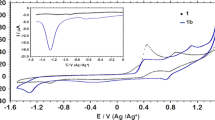Abstract
Transformation products of the cationic rhodium complex [(1,5-COD)Rh(—)R,R-DIOP]+CF3SO3 – (1) (COD is cycloocta-1,5-diene and DIOP is (±)-2,3-O-isopropylidene-2,3-dihydroxy-1,4-bis(diphenylphosphino)butane), which were obtained in its reactions with molecular hydrogen, base (NEt3), and solvents in the absence of a substrate, were investigated by 1H and 31P NMR spectroscopy. The solvate complexes [(Solv)2Rh(—)R,R-DIOP]+CF3SO3 –, which were generated from complex 1 in its reaction with molecular hydrogen, underwent destruction of the diphosphine ligand with elimination of benzene and were subjected to oxidation by traces of moisture and oxygen to form the DIOP dioxide complex with RhI. In the absence of hydrogen, complex 1 in solutions produced the diphosphine dioxide rhodium(i) complex and mono- and binuclear rhodium(i) solvate complexes. The scheme of deactivation of the complex in the absence of the substrate was proposed. The catalytic activity of the solvate complexes [(ArH)Rh(—)R,R-DIOP]+CF3SO3 –, which contain benzene, p-xylene, and mesitylene in the coordination sphere, was studied in hydrogenation of Z-α-acetamidocinnamic acid.
Similar content being viewed by others
References
L. O. Nindakova, B. A. Shainyan, A. I. Albanov, and M. V. Ustinov, Zh. Org. Khim., 2000, 35, 1660 [Russ. J. Org. Chem., 2000, 35 (Engl. Transl.)].
H. B. Kagan and T.-P. Dang, J. Am. Chem. Soc., 1972, 94, 6429.
D. Sinou and H. B. Kagan, J. Organomet. Chem., 1976, 114, 325.
J. Reiss and J. Hetflejs, Coll. Czech. Chem. Commun., 1986, 51, 340.
J. M. Brown, P. A. Chaloner, A. G. Kent, B. A. Murrer, P. N. Nicholson, D. Parker, and P. J. Sidebottom, J. Organomet. Chem., 1981, 216, 263.
A. J. Kirby and S. G. Warren, The Organic Chemistry of Phosphorus (Reactions in Organic Chemistry), Elsevier, New York, 1967.
D. Purdela and R. Vylchanu, Khimiya organicheskikh soedinenii fosfora [Chemistry of Organophosphorus Compounds], Khimiya, Moscow, 1972, 752 pp. (in Russian).
31 P Nuclear Magnetic Resonance, in Topics in Phosphorus Chemistry, Vol. 5, Eds. M. Grayson and E. J. Griffith, Wiley and Sons, New York-London-Sidney, 1967, 489 p.
K. Yamamoto and S.-U. Rehman, Chem. Lett., 1984, 1603.
E. Dunach and H. B. Kagan, Tetrahedron. Lett., 1985, 26, 2649.
A. R. Sanger, J. Chem. Soc., Chem. Commun., 1975, 893.
G. W. Parshall, Acc. Chem. Res., 1970, 3, 139.
T. Nishiguchi, K. Tanaka, and K. Fukuzumi, J. Organomet. Chem., 1980, 193, 37.
A. S. C. Chan and J. Halpern, J. Am. Chem. Soc., 1980, 102, 838.
M. D. Fryzuk and B. Bosnich, J. Am. Chem. Soc., 1977, 99, 6262.
Author information
Authors and Affiliations
Rights and permissions
About this article
Cite this article
Nindakova, L.O., Shainyan, B.A. Transformations of the chiral diphosphine rhodium catalyst [(1,5-COD)Rh(—)R,R-DIOP]+CF3SO3– under conditions of hydrogenation. Russian Chemical Bulletin 50, 1855–1859 (2001). https://doi.org/10.1023/A:1014338330802
Issue Date:
DOI: https://doi.org/10.1023/A:1014338330802




